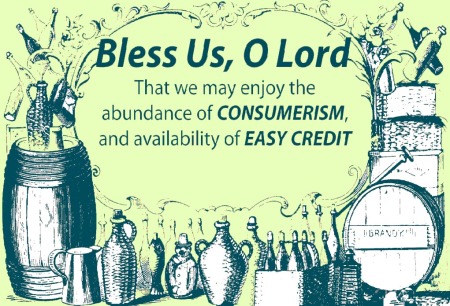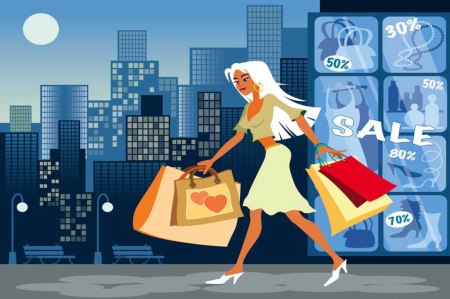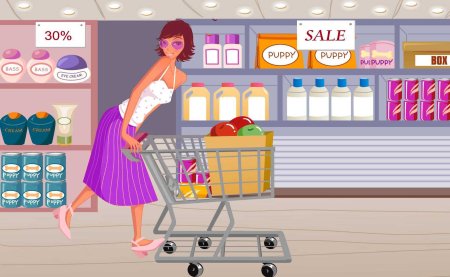This text was first published in 2011 but its content is not outdated at all. The supermarket that I then visited and subsequently featured in a blog post still exists, even the less than energy-efficient lighting is still the same. When I inspected the facility a few weeks ago, it was packed with people, one can assume, that turnover is as high as ever.
This business is a cash cow, guarantying steady profits without new investments and only minimal maintenance. One has to wonder, what the owners do with all that money.
Though it is undeniable, that shopping still keeps the upper class and the (dwindling) middle class in Western countries as well as the parvenus and nouveau riche in the so-called “developing countries” entertained and happy, there is a growing number of consumers for which, because of stringent austerity measures, shopping is not the same innocent fun as it once was. But who cares, in lack of sufficient income people just deplete their savings or take another loan in order to keep the great tradition of shopping alive.
Environmentalists also try to spoil the shopping experience with appeals to minimize our carbon footprint, obligating businesses to go green and stress their environmental record. “Going green” means, that everything is painted green, that shelves are full of “organic” food, and all packing material has a note that it can be recycled in one way or the other. Not that it would make much difference if this measures would not be taken, they are just a matter of precaution — the companies want to be on the safe side.
While farmers markets are doing fairly well and some people start to grow their own food, supermarkets are still the main distributors of basic supplies and it doesn’t look as if this will change soon. It also cannot be denied that shopping addiction is epidemic as ever.
So — in the face of overwhelming evidence your concerned anti-consumerism insurgent grudgingly has to admit that there is still a lot of life in consumerism. This scheme has not run its course yet!
Mai is not a typical shopping season but I was nevertheless forced a few weeks ago to buy some necessities in a supermarket. Normally I avoid wasting my days with shopping and I leave this task to friends or relatives, but this time I had nobody to help me out and so I had to go by myself.
The shopping list was short and included toilet paper and kitchen tissue, tooth brushes and tooth paste, soap and shower gel, laundry detergent, bananas, rolled oats, lentils, whole grain rice, cheese. All items which are not available from the farmers market and also don’t grow in my garden.
I always buy organic food and/or “fair trade,” if available, though I consider the organic sections in supermarkets as a scam. Even if the food is grown with less pesticide use, it is still shipped over long distances and lavishly packaged. “Organic” simply is the new “premium,” meaning: A bit less polluted and less rotten.
I walked through the aisles as fast as possible looking for the items on my shopping list but the variety of colors and shapes made my head spin. Fortunately this particular shop is rather frugal (no frills) compared with competitors, it offers only about 400 – 600 products instead of the 10,000 or more, which may be on display in other shops.
The store belongs to Aldi, a German based company which operates thousands of middle sized supermarkets all around the world. Aldi is not Wal-Mart, but the company has nearly 10,000 outlets in 19 countries and a turnover of 51 billion Euros. Theo Albrecht, one of the two brothers who founded the company, died in 2010. He was the richest German, worth some 20 billion US$.
That is not bad even compared to Wal-Mart. The six heirs of Bud Walton, founder of Wal-Mart, were estimated to possess about 70 billion US$ in 2007 (this is by the way the equivalent of wealth that is owned by the bottom 30 percent of US-Americans.)
Back to my shopping experience. The shop is one of the bigger Aldi branches, the sales area is about 1,400 square meter. Aldi shops normally have between 800 and 1,200 square meter sales area. Around the supermarket building is a large parking space, the whole complex covers approximately 10,000 square meters. The shop is open eleven hours a day on six days a week.
I looked at the ceiling and discovered, that the lighting, which is on all the time regardless of the time of day is a combination of halogen lamps and fluorescent light bars. The halogen lamps are probably used to achieve a more pleasant and warm light. I stopped for a moment and counted 16 halogenic lamps in 10 rows. Just by accident I know that one lamp consumes 50 watts, that makes 8,000 watts for the whole hall. The linear fluorescent light bars were covering nearly the whole ceiling, this technology is far more energy efficient than the halogen lamps but the fluorescent lamps were of the 1200 by 300 mm T-bar kind which usually consume 2 times 36 watts. I estimated that the light bars would need about 9,000 watt and the total electrical power consumption for lighting would be therefore 17,000 watts.
It was a rather cold day but the shopping hall was warm, which reminded me of the fact, that all these supermarkets have an electric heating and air conditioning. The Aldi corporation prides itself as being environmental friendly, Aldi USA for instance commissioned Eagle Mountain’s Center for Green Technology to design and install a geothermal heating and cooling system for the store in Farmington, NY. The East Syracuse store uses LED lighting and an energy management system which is turning off lights in areas where there’s no traffic and makes sure lights aren’t inadvertently left on by employees when the store is closed.
An Aldi store in Austria is mentioned and lauded by the GreenBuilding initiative of the European Commission. The store uses a heating pump which is combined with the cooling to recycle the warmth that is generated by the cooling. Other stores use a CO2 based refrigeration system (microox ® CO2 gas cooler) and state-of-the-art heat exchangers. New stores use massive thermal isolation and low-emissivity glass plus double or triple glazed windows.
All these measures combined are said to reduce the primary energy demand of stores, which is normally 80,000 kWh per square meter and year by half. I’m just checking the numbers:
40 kWh per square meter and year should be the energy demand of a “Green Building”. This store has 1,400 square meter which would mean a yearly consumption of 56,000 kWh. The store is open 52 weeks x 6 days – 14 holidays = 298 days x 11 hours = 3,278 hours. 56,000 kWh divided by 3,278 are 17,084 watts average energy use.
That is what I estimated to be the energy consumption of the lighting alone. My estimation could have various flaws, maybe the halogenic lamps are only 30 watt and the fluorescent light bars use only 2 x 24 watts, a recalculation shows that the energy consumption of the lighting would then be only 11,000 watts. This is still too much, and the use of halogen lamps alone makes this particular store fail the “Green Building” standards.
The energy efficiency in lumen per watt is for
incandescent lightbulbs 10 – 16
halogen lamps 12 – 20
compact fluorescent 60 – 70
fluorescent bars 30 – 110
LEDs 60 – 120
halogen lamps 12 – 20
compact fluorescent 60 – 70
fluorescent bars 30 – 110
LEDs 60 – 120
Back to my supermarket shopping adventure. As I walked through the aisles and passed the cereals section, I was astonished how many varieties of corn flakes are sold even in a no frills shop with a comparatively small range of goods. Especially the “Honey Smacks” and “Golden Crips” packages caught my eyes and reminded me of a report published a few weeks ago that cereal products aimed at children contain more and more sugar. Food companies spent fortunes on advertising cereals as the best breakfast for kids and the investment pays off now with sugar-cereals being the most profitable products for the companies.
The wide acceptance of these sugar-cereal combinations is good news for the industry and bad news for children and parents. 60 years of nutrition research has confirmed again and again that sugar is the single most health-destructive component of the standard Western diet. Children who eat breakfasts with high sugar content have more problems at school. They become more frustrated and have a harder time working independently than kids who eat low-sugar breakfasts. By lunchtime they have less energy, are hungrier, show attention deficits and make more mistakes.
I have only a comparison chart from USA but European products are probably not much different.
| Worst Children’s Cereals based on percent sugar by weight | |
| 1.) Kellogg’s Honey Smacks | 55.6% |
| 2.) Post Golden Crisp | 51.9% |
| 3.) Kellogg’s Froot Loops Marshmallow | 48.3% |
| 4.) Quaker Oats Cap’n Crunch’s OOPS! All Berries | 46.9% |
| 5.) Quaker Oats Cap’n Crunch Original | 44.4% |
| 6.) Quaker Oats Oh!s | 44.4% |
| 7.) Kellogg’s Smorz | 43.3% |
| 8.) Kellogg’s Apple Jacks | 42.9% |
| 9.) Quaker Oats Cap’n Crunch’s Crunch Berries | 42.3% |
| 10.) Kellogg’s Froot Loops Original | 41.4% |
After the cereals I passed the other packaged foods and was impressed but not tempted by the various chocolates, cakes, biscuits, candies, and snacks. A whole aisle with food that has practically no nutritional value and contains mainly sugar, fat, white flour or starch, salt, and additives like antioxidants, preservatives, thickening and glazing agents, artificial flavoring and coloring, oleochemicals, silicones, waxes, and a whole lot more from the chemical laboratories of the food industry.
Household goods like toothbrushes and toilet paper and most of the other things on my shopping list were at the very end of the hall as far away from the entrance and the checkout as possible. This is an age old trick forcing the customers to pass all the goods that are not essential but could be appealing and trigger an impulse purchase.
I saw only a few cans, canned food is not popular anymore, people have already consumed enough bisphenol A.
This is a gigantic field experiment with billions of guinea pigs, I thought, and just following my free flowing associations while I walked through this consumer wonderland it came to my mind, that children with ADHD improved significantly when food with special artificial coloring (sunset yellow FCF (E110), quinoline yellow (E104), carmoisine (E122), allura red (E129), tartrazine (E102) and ponceau 4R (E124)) and the preservative sodium benzoate was eliminated from their diet.
The Romans had lead (used for water pipes, pots and drinking cups), we have chemical food additives, bisphenol A, and all kind of other environmental pollutants (POPs, heavy metals), which inevitably enter the food chain. In addition to the mentioned trace substances meat is laced with antibiotics and hormones, especially the ones which mimic estrogen and make men infertile.
The latter mentioned fact could become an unexpected solution of the environmental problems that human overpopulation causes and also lead to unexpected alliances. Where are the conspiracy theorists, fuming about Nazi inspired eugenics and population control? Where are the machos, anxious about their reproductive capacity? Finally they all have a chance to team up with the environmental movement and start growing their own vegetables and fruits!
I fetched a few pieces of cheese from the refrigerated section, hoping that the labels which suggest no preservatives and GE-free are truthful. Regulations are controlled and strictly enforced here, so there is a chance that labeling is correct. The refrigerated section in this store covers nearly the whole length of the hall. Even if the extracted warmth from the cooling area is used to supply the heating on cold days, the power consumption and the resulting carbon footprint must be considerable (1000 – 3000 watts).
After collecting everything on my shopping list, I went back to wait in line at the checkout.
The girl at the counter was below 20 and according to her badge, an apprentice. She had black dyed hair with violet and green streaks, nose and eyebrow piercings, black nail polish. Some of the pupils in the music school look exactly like that and so I know that this outfit indicates a preference for heavy metal music. Heavy metal music is an influential part of our popular culture and comes in distinct varieties that suit a wide range of tastes, hearing impairments, and mental disorders. At offer are death metal, trash metal, extreme metal, gothic, sludge, doom — I know it all, (courtesy of my students).
The girl wore the company uniform, a long sleeve, navy blue blouse and trousers, so I couldn’t see if she wore tattoos. It would have been very unusual though if she wouldn’t have been tattooed, because tattooing has become an initiation rite. Boys and girls flock to the tattoo shops/studios/parlors to have their skin decorated with various more or less meaningful and more or less explicit graphics in every possible place. Lacking tattoos is painfully uncool and shows a nearly criminal carelessness about fashions and trends.
I wondered, what would happen if this girl and I would be trapped on a lonely island. Would we both flee to the most opposite corners of the island and try to avoid any contact or would over time some strange relation be established or even a faint sexual attraction arise? I think, despite the enormous differences, that this girl and I still belong to the same species (aren’t Chihuahuas, Collies, Golden Retrievers, and German Shepherds all considered to be dogs?)
I will probably never be able to completely overcome and eradicate the intolerance and the cynicism, that are part of my character and that I manifested in the last paragraphs. I am working since decades to alleviate this flaws but every now and then a feeling of contempt and aversion overtakes completely and I view a particular person not as fellow human being but as an annoyance and burden.
Why shouldn’t the kids show their allegiance to popular culture? Body paint and piercing are part of human civilization since millennia. The hair dye and formaldehyde plus other solvents of the nail polish may be unhealthy, but it is their health and their choice.
Unfortunately the production of cosmetic chemicals and popular gadgets which — after being promoted, celebrated, and propagated by all media — have become a necessary part of modern youth culture (and consumer culture or Western lifestyle in general), effects my health too. The kids are entitled to create their own rituals and their own aestheticism but they don’t do that, they are just brainwashed by advertising to buy unnecessary crap, they are distracted, sedated, and led like cattle to the temples of consumerism.
Their culture was not designed by themselves, it was designed in the corporate laboratories to maximize the profits of companies.
I took the wallet out of my pocket while I was slowly advancing in the line. The wallet is of blue leather and I have it now for about 20 years. As I don’t like to go shopping and also conduct most financial transaction online it is not used much, but it nevertheless is nearing the end of its life expectancy.
I try to keep my belongings in good order and treat them carefully and I try to use everything as long as possible. I didn’t buy cloth in the last ten years. My former wife bought me a pair of blue jeans and leather sandals and I got two shirts from my stepson because he didn’t like them, but that was also years ago. I am in and out of fashion cycles and I’m definitely out of consummation trends.
In the mid-1990s, the average US citizen bought 28 items of clothing a year, today she or he buys 59 items. Which makes me wonder — did they go naked half of the time in the 1990s?
My cloth all goes through three phases of use, which are: Outdoors, indoors (including garden and forest), and cleaning rag. The cloth that I wore at this shopping trip was all phase one (at least in my opinion), it was a turtleneck, a jean, sneakers, and a leather jacket. Today I wouldn’t buy a leather jacket anymore because of my admiration and affection for my animal friends.
I don’t try to justify my apparent misdeeds of earlier years, I only want to add that the leather jackets in my possession are ages old and hail from a time where my consumption patterns admittedly didn’t match my environmental beliefs. Now that I have the jackets I will not throw them away, they are useful and practical and last forever — they will for sure outlast me.
(I never owned a fur coat, at least this line I didn’t cross.)
I had put my goods onto the conveyer belt while considering all the mentioned aspects of my consumer existence and suddenly it was my turn and the cashier had scanned the goods and had shoved them back into the cart. She didn’t ask me, if I wanted to pay with credit card or cash, she probably assumed that a person like me would not have a credit card (thats right, I don’t have a credit card).
She seemed surprised, when I pulled out a banknote from my worn out wallet, she probably had rather expected me to run with my shopping cart to the exit without paying. I took the change and while I turned to the exit I heard her say: “Have a nice day”. This was probably one of a dozen phrases she was trained to say to the customers and it sounded, as if she would have pressed the button of a jingle machine in a broadcast studio.
I dragged the cart to my car and filled up the boot. It was nearly 30 kg, the supply of roughly 4 month. 30 kg, 4 kg of which is packing material, in a car that weighs 1,100 kg plus 30 kg fuel in the tank, driven by me weighing 66 kg. 1,100 + 30 + 66 + 4 = 1,200 kg.
I would now drive home 11 km and after parking the car into the garage the spent fuel would have moved 1,200 kg of metal, plastic, fuel, packaging, and me just to transport 26 kg of goods! This is insane, this is unsustainable, this is criminal negligence, I thought. And I felt guilty as I always do….
There are alternatives:
A delivery system from stores to customers for instance would reduce the transport costs by 80 to 90 percent. Such a system could be installed immediately, the necessary technology and infrastructure exists already in form of internet shopping sites and postal services. Yet the full potential of home delivery could only be reached with a unified service because the rivalry between competing companies and parcel services would cause unnecessary and unwanted duplicity.
I dare to dream, and in my vision of an ideal society and an ideal economy businesses would not compete but cooperate, would have to deliver necessary services to fair prices, would be owned by the employees, and would be accountable to both the employees and the customers.
I dare to dream, and in my vision of an ideal society and an ideal economy there would be no need for shopping and the time that is wasted now by the affluent people in the Western world to stroll around in supermarkets and shopping malls would be used more productively and purposefully for:
learning and teaching,
fixing things and inventing novel and clever solutions for all the small and big problems that arise, as we go on in our lives,
growing food (garden work),
art (writing, painting, music),
social interaction and meditation,
walking in the forest, watching nature, listening to the birds, being lazy and doing absolutely nothing
fixing things and inventing novel and clever solutions for all the small and big problems that arise, as we go on in our lives,
growing food (garden work),
art (writing, painting, music),
social interaction and meditation,
walking in the forest, watching nature, listening to the birds, being lazy and doing absolutely nothing
Doing nothing, thats my plan when I have finally updated, polished, and published this text!






Keine Kommentare:
Kommentar veröffentlichen